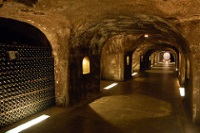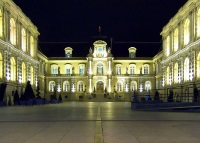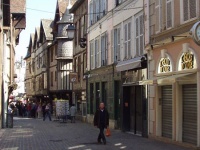Champagne Country Travel Guide
Legend has it that the Champagne region of France should be forever indebted to Dom Pérignon, the Benedictine monk who in the 17th century accidentally discovered how to create bubbly, or sparkling wine, in the cellar of an abbey at Hautvilliers. Ever since then, champagne has been synonymous with celebration and opulence, with corks popping at great occasions all over the world. It is believed that during the Renaissance the only thing Henry VIII of England and François I of France could agree on was a penchant for champagne, and it is recorded that Napoleon, a friend of Jean-Rémy Moët, took a case or two with him to every battle, except Waterloo.
Champagne and the Ardennes have been the scene of many conflicts over the centuries, most recently during both 20th-century World Wars, in which many towns and villages were destroyed. Still worth visiting, though, are the cities of Amiens, Reims and Laon (which retain their magnificent medieval cathedrals), the lovely town of Troyes, and the historic village of Jouarre with its beautiful Benedictine abbey. This region of France also sports numerous war memorials and soldiers' cemeteries, which are places of pilgrimage for many foreign visitors whose forefathers died fighting here.
Things to do in Champagne Country
Unsurprisingly, the most popular thing to do in Champagne Country is drink champagne. However, the region has plenty to offer visitors and the attractions are varied. Champagne Country is interesting from a military history perspective and has many military monuments, museums and battlefields. Despite heavy bombing of the cities during World War II, there is also still some quality medieval architecture to be found.
Tourists should head for Epernay and Reims to sample the best bubbly on offer in the region. Epernay hosts many of the great champagne houses and visitors can tour the cellars of both Moët et Chandon and Mercier. In Reims the Maison de Pommery, Mumm and Veuve Clicquot, among others, wait to entertain guests. Both of these cities, though ancient, have suffered from wartime destruction and now seem industrial and modern. They do have some gems for the historical sightseer, though, such as the magnificent Cathedrale Notre-Dame de Reims, where dynasties of French monarchs were crowned.
The quaint and well-preserved old town of Troyes, which dates back to the Roman era, gives visitors an idea of how the grand cities of the region must once have looked. It is jam-packed with picturesque old buildings and interesting museums, as well as several incredible churches.
Amiens is a good base from which to explore the battlefields, cemeteries and memorials of World War I. Possibly the best place from which to explore battle sites in the Champagne Country is the industrial town of Chateau-Thierry, where the surrounding countryside has borne witness to great battles during both world wars. Here visitors can explore the WWI Aisne-Marne American Cemetery and the Belleau Wood battlefield, among other moving sites.

Epernay
Epernay, along with Reims, is one of the great centres of champagne production. Dug into the chalk beneath the town are more than 200 miles (322km) of cellars and tunnels containing champagne from the surrounding area, including such great brands as Moët et Chandon, Pol Roger, Mercier, and de Castellane. Sadly, as Epernay did not fare well in several wars over the centuries, few old buildings remain in the town despite its rich history. In the central and oldest quarter of the town, the streets are narrow and irregular and one can feel the age of the place, but apart from one church that retains some features from the 16th century, the buildings are modern.
Generally the surrounding suburbs are modern and spacious but the many opulent villas belonging to rich wine merchants lend an air of sophistication to the town. However, the main reason people flock to Epernay is to visit the great champagne houses and the lack of ancient architecture doesn't deter many. Both Moët et Chandon, the world's largest producer of bubbly, and Mercier give guided tours of their cellars, in English, throughout the day. They are situated near each other on Avenue de Champagne. Castellane also has daily tours from March to December.
Travellers can also fly over the vineyards in a hot air balloon and enjoy a glass of champagne while they're up there. It's best to go up between May and September to see the vineyards at their greenest.
Reims
A visitor's first impression of Reims (pronounced Rhance) is of a sprawling industrial town peppered with concrete apartment blocks, the result of World War I bombs and later disastrous town planning. However, Reims is an ancient Roman city and the birthplace of the French nation; it contains one of the most impressive Gothic cathedrals in France, the Cathédrale Notre-Dame de Reims, where dynasties of French monarchs were crowned starting with Clovis, first king of the Franks. The neighbouring Basilique St-Rémi is even older and, half Gothic, half Romanesque in style, includes the old royal abbey that is now a museum documenting the history of the town.
Most visitors come to Reims not so much for history but for the hedonistic pleasure of visiting the cellars of its great champagne producers. This is the home of the world's best bubbly. The best of the best is to be sampled at the Maison de Pommery, which has more than 10 miles (16km) of tunnels extending 100ft (30m) down into the chalk below its Gothic superstructure. Travellers can then move on to Mumm, which contains 25 million bottles of slowly fermenting champagne in its vaults, and then Taittinger and Veuve Clicquot. All offer a guided tour of the cellars and champagne making process, followed by a tasting.
Foodies should not miss the opportunity to sample the elegant local cuisine, which can be paired with champagne. Reims ham, truffles, a variety of cheeses, Reims mustard and the light, crunchy, vanilla-flavoured pink biscuits are among the must-try items on offer.
Château-Thierry
Château-Thierry is an industrial town 55 miles (89km) east of Paris on the River Marne. The surrounding countryside was the site of many great battles during both World Wars and a number of monuments and cemeteries mark the bravery of thousands of Allied soldiers who fought to liberate France and, who now lie interred under her soil. One of the most popular and rewarding memorial sites for tourists is the WW1 Marine Memorial at Belleau Wood, which is located by the WW1 Aisne-Marne American Cemetery and the Belleau Wood battlefield. The Chateau-Thierry Monument is a good place to start when investigating the military history of the area as it lists the units that fought in the region as well as providing a battle map and orientation table.
The town is also known as the home of the famous poet and fable writer Jean de la Fontaine (1621-95); the Musée Jean-de-la-Fontaine is one of the most popular literary museums in the world and contains a collection of his personal effects, memorabilia and a number of editions of his works. Travellers can visit the Walt Disney Studio in Chateau-Thierry too, where they can explore the behind-the-scenes production world of movies and television. Unfortunately, the chateau that gave the place its name has long been destroyed and very little remains of the old part of the town.

Amiens
Amiens is the ancient capital of Picardy and lies on the River Somme, 75 miles (121km) north of Paris and 65 miles (105km) south of Calais. Walking around the maze of narrow streets, divided by canals, visitors may feel that this is a city past its prime; nevertheless, there are definitely a couple of sites worth exploring.
The city's centrepiece is the Gothic cathedral, built between 1220 and 1270, which is one of the finest in France. The interior contains wonderful examples of medieval masonry and woodwork; 126 slender pillars hold up the vast structure and the stalls are decorated with thousands of carved figures. Like most great churches it has been added to and restored over the centuries.
The nearby Musée de Picardie displays the history and art of the region from prehistoric times through to the present day, along with exhibits from the Roman, Greek and Egyptian empires. The art collection includes European paintings and sculptures from the 16th century, including works by El Greco, Fragonard, Guardi, and Tiepolo. As Amiens also played a vital role in the First World War, there is plenty of military history to explore in the area, including some significant and famous battlefields, cemeteries, German bunkers, a battlefield park and a museum.

Troyes
Those who are tired of fighting off the summer crowds in Champagne Country will find a refreshing alternative in the quaint old town of Troyes, which is a little off the tourist track and is full of genuine French appeal. Troyes has been settled since the Roman era and has a rich history, along with many interesting museums and old churches to visit. In the beautifully restored city centre of quaint narrow streets, Renaissance mansions and pretty old houses stands one of France's most magnificent Gothic cathedrals.
Troyes was lucky to avoid destruction during war, which is partly why it has so many historic buildings still standing; apart from the magnificent Saint-Pierre-et-Saint-Paul Cathedral, visitors should look out for other worthwhile old churches including Saint-Nizier Church, which has remarkable sculptures, the 13th-century Saint-Urbain Basilica, and Saint-Nicolas Church, a Gothic building dating back to the early 16th century.
Strolling around the old part of town is one of the primary delights of Troyes, and there are numerous good restaurants and cafes. The city also boasts a private collection of art housed in the old bishop's palace, the Musée d'Art Moderne, which displays works by Bonnard, Degas and Gauguin.
France travel info
Electricity
The electrical current is 230 volts, 50Hz. European two-pin plugs are standard.
Language
French is the official language.
Money
The euro (EUR) is the official currency in France. Currency can be exchanged at banks, bureaux de change and some large hotels, though visitors will get a better exchange rate at the ATMs. Major credit cards are widely accepted, particularly in major tourist destinations. Foreign currency is not accepted.
Tipping
Most restaurants and hotels automatically add a 15 percent service charge so a tip is not necessary, although another two to three percent is customary if the service has been good. If service is not included then 15 percent is customary. Taxi drivers expect 10 to 15 percent of the fare, and hairdressers about 10 percent. Hotel staff generally receive about €1.50 a day and tips of about €1 are given to washroom and cloakroom attendants and museum tour guides. Tour bus drivers and guides are also tipped.
Health
No particular vaccinations or medications are required for travel to France. The prevalence of certain tick-borne infections, such as lyme disease, tularemia, tick-borne encephalitis, and rickettsial diseases, mean that travellers should take precautions against ticks if they are travelling in rural or forested areas in warm weather. French hospitals and health facilities are first class. Visitors from other EU countries are entitled to discounted medical treatment and medicines on presentation of a European Health Insurance Card (EHIC). After Brexit, the Global Health Insurance Card (GHIC) replaced the European Health Insurance Card (EHIC) for UK citizens. The GHIC allows UK citizens access to state healthcare during visits to the EU. The GHIC is not valid in Norway, Iceland, Liechtenstein or Switzerland, nor is it an alternative to travel insurance. Otherwise, doctors and hospitals often expect immediate cash payment for health services, so medical insurance is advised.
Safety
While violent crime against tourists is rare and holidays in France are generally trouble-free, visitors should be mindful that security has been heightened following a series of terrorist attacks in recent years, particularly in the transport sector. Unattended luggage left in public places will be removed or destroyed by security staff. While generally safe, visitors to France are advised to take precautions against petty theft and to ensure their personal safety. Thieves and pickpockets operate on the metro and around airports. Theft from cars is prevalent, particularly in the south, around Marseilles, and in Corsica. Tourists are advised to conceal bags and purses even when driving, and to never leave valuables unattended in the car. Bag snatching is also common, particularly on public transport and in shopping centres, and visitors should also be vigilant of luggage while loading bags into and out of hire cars at airports.
Local customs
French culture is of paramount importance to the French people. In an increasingly Americanised world they feel duty-bound to protect it, and it is appreciated if visitors can speak a few words of French. Locals do not respond well to being shouted at in English. While the food is second to none, foreigners may find the service in many restaurants sloppy. Waiters can appear rude (particularly in Paris) and take their time. This is just the way they are. Traditional games such as pétanque (similar to lawn bowling but played on gravel) are popular in village squares, but the national sports are football, rugby and cycling. Smoking in public places is not allowed and will incur heavy fines.
Doing business
Business etiquette is important in France. A smart, fashionable sense of dress is common as the nation prides itself on haut couture. Punctuality is not always observed though and the 'fashionably late' tactic may be applied. A handshake is the common form of greeting for men and women upon first introductions. Titles are important and the person is to be referred to as 'monsieur' (Mr.), 'madame' (Mrs.), or 'mademoiselle' (Ms.). Meetings usually occur over lunches, and the French are known to enjoy food. Business hours are generally 9am to 6pm, Monday to Friday.
Duty free
Travellers from non-EU countries over 17 years of age entering France can bring in the following items duty-free: 200 cigarettes, or 100 cigarillos, or 50 cigars, or 250g tobacco. Four litres of wine and 16 litres of beer and one litre of spirits over 22 percent or two litres of alcoholic beverages less than 22 percent. Other goods up to the value of €430 for air and sea travellers, and €300 for other travellers (reduced to €175 for children under 15 years of age).
Communications
The international access code for France is +33. Travellers can purchase local prepaid SIM cards for unlocked phones or use eSIMs if their cellular providers support it on their networks. Free WiFi is available in most hotels, cafes, restaurants and similar establishments.
Passport & Visa
The borderless region known as the Schengen Area includes the following countries: Austria, Belgium, Czech Republic, Denmark, Estonia, Finland, France, Germany, Greece, Hungary, Iceland, Italy, Latvia, Lithuania, Luxembourg, Malta, The Netherlands, Norway, Poland, Portugal, Slovakia, Slovenia, Spain, Sweden, and Switzerland. All these countries issue a standard Schengen visa that has a multiple entry option, and which allows the holder to travel freely within the borders of all the aforementioned countries.
Additionally, travellers must hold sufficient funds to cover their stay in France, and proof of repatriation (a return or onward ticket, and the necessary travel documentation for their next destination). Note that Schengen visas, if required, are also valid for French Guiana and French West Indies and Reunion, provided that the Schengen visa is endorsed "Also valid for French territories being in observation of the respective French territories". We recommend that passports always be valid for six months after intended period of travel.
Entry requirements
US citizens must have a passport that is valid for at least three months after their intended stay in France. No visa is required for a stay of up to 90 days within a 180 day period.
UK citizens must have a passport that is valid for at least three months after their intended stay in France. No visa is required for a stay of up to 90 days within a 180 day period.
Canadian citizens must have a passport that is valid for three months after their intended stay in France. No visa is required for a stay of up to 90 days in a 180 day period.
Australian citizens must have a passport that is valid for three months after their intended stay in France. No visa is required for a stay of up to 90 days in a 180 day period.
South African citizens must have a passport that is valid for three months after their intended stay, and a valid Schengen visa, to enter France. Note that entry and transit will be refused to holders of Temporary passports.
Irish citizens must have a passport that is valid on arrival. No visa is required.
New Zealand citizens must have a passport that is valid for three months after their intended stay in France. No visa is required for a stay of up to 90 days in a 180 day period.
Useful contacts
Maison de la France (Tourist Information Agency), Paris: www.france.fr/fr
112 (General emergency)Embassies / consulates in other countries
French Embassy, Washington DC, United States: +1 202 944 6195.
French Embassy, London, United Kingdom: +44 (0)20 7073 1000.
French Embassy, Ottawa, Canada: +1 613 789 1795.
French Embassy, Canberra, Australia: +61 (0)2 6216 0100.
French Embassy, Pretoria, South Africa: +27 (0)12 425 1600.
French Embassy, Dublin, Ireland: +353 (0)1 277 5000.
French Embassy, Wellington, New Zealand: +64 (0)4 384 2555.
Embassies / consulates in France
US Embassy, Paris: +33 (0)1 4312 2222.
British Embassy, Paris: +33 (0)1 4451 3100.
Canadian Embassy, Paris: +33 (0)1 4443 2900.
Australian Embassy, Paris: +33 (0)1 4059 3300.
South African Embassy, Paris: +33 (0)1 5359 2323.
Irish Embassy, Paris: +33 (0)1 4417 6700.
New Zealand Embassy, Paris: +33 (0)1 4501 4343.



